Though a radiant bowl of borscht may strike you as unfamiliar, I get all the feels when one’s placed in front of me.
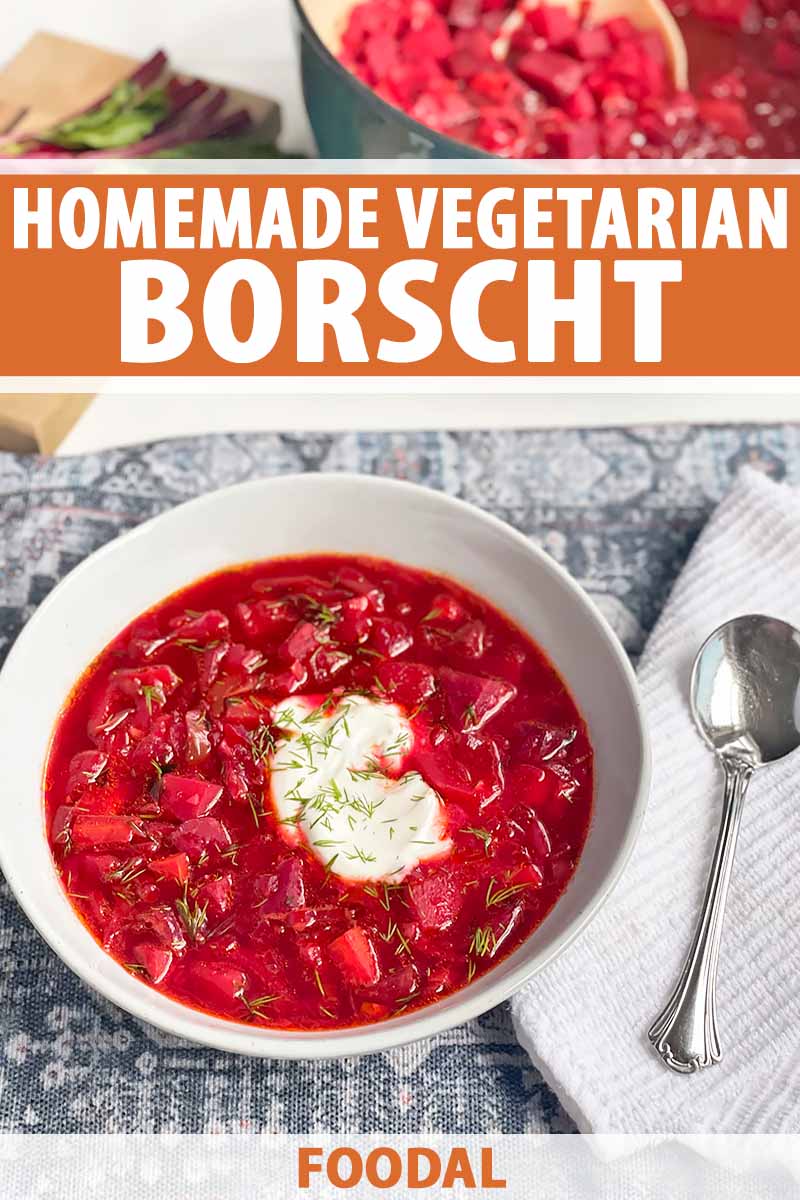
Oops, my eastern European roots are showing.
Famous for its striking shade of magenta, this beet-infused soup is something I grew up eating. And while the particular recipe we’re talking about today is served up steaming hot and filled with hearty winter veggies, it’s the chilled version that featured prominently throughout my childhood.
The mere thought of the intensely purple broth sends a tidal wave of comfort through my ocean of food memories.
In the midst of each sweltering North Carolina summer, my dad would stand barefoot in front of the blender, pulsing a batch of his beloved borscht. His was a quick-fix combination of cucumbers, onion, and beets buzzed until smooth. It was delicious and never lasted long.
A cool dollop of sour cream added richness to the tart broth that he spritzed with lemon juice while sweet, fragrant dill perfumed every bite with bright grassy notes. Luscious and refreshing, I lived for this cold soup in the muggy months.
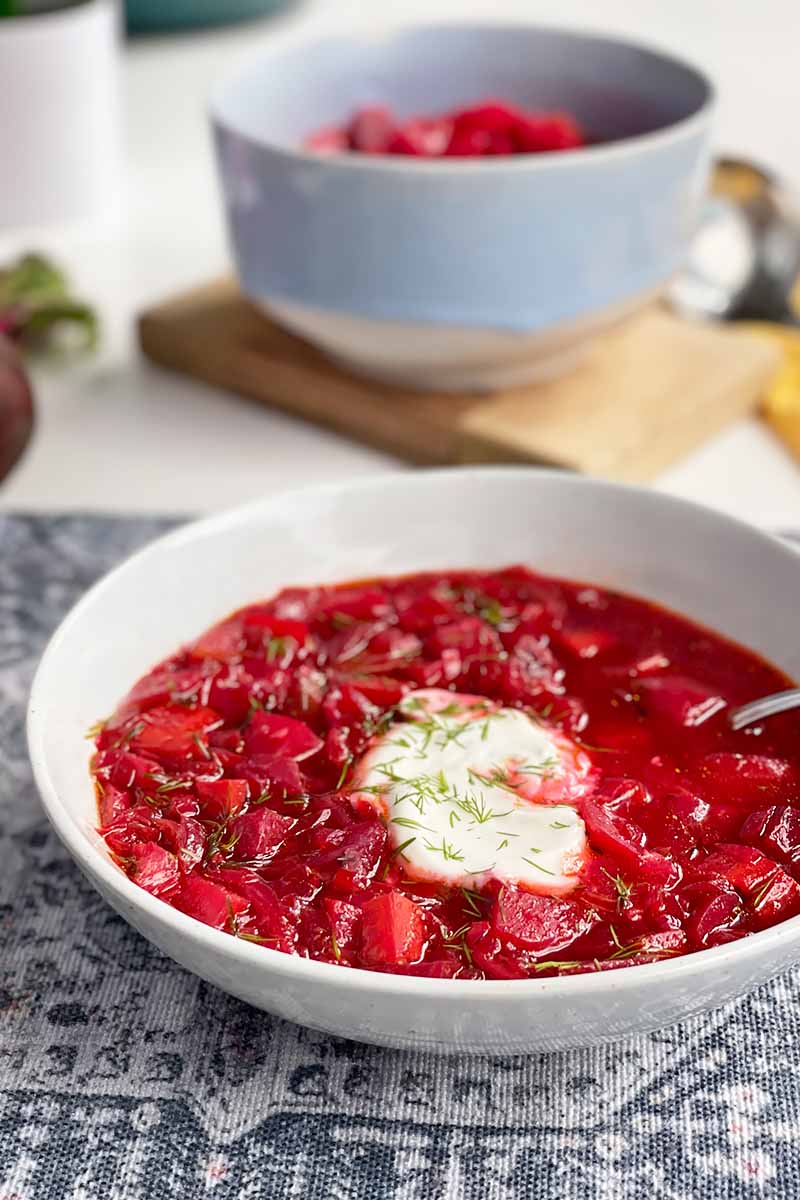
I can still see the glowing Tupperware container of it in the fridge, and I remember popping off a corner of the lid and sneaking smells when I was younger, and not yet brave enough to dish out my own bowl.
When I asked how borscht became a regular in his cooking repertoire, my dad lovingly recalled his grandma Fannie (my namesake, thank you very much) making it, as well as a Hungarian sweet and sour soup prepared with flanken – a heavily fat-marbled style of beef short ribs.
My dad was the only one of his siblings with a soft spot for these unique broth-based delicacies, yet he is now the sole member of the trio who doesn’t eat red meat. That being the case, I couldn’t wait to call and tell him all about the vegetarian borscht I was preparing in my own kitchen.
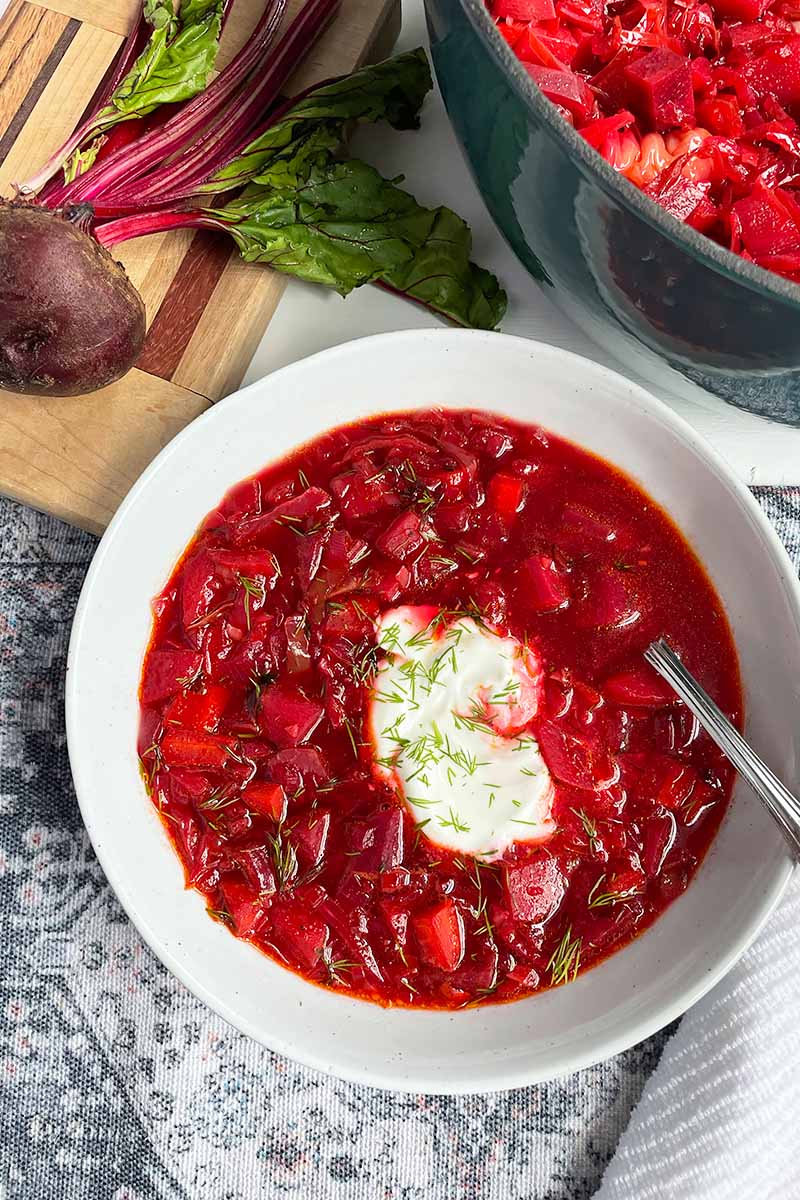
He was surprised to learn that my recipe came to fruition on the stovetop, but borscht can be eaten hot or cold. As with many classic dishes, there’s some controversy surrounding its legacy.
The dish first emerged in the class of peasant food, as it was produced out of pure necessity. It’s remained prominent as a staple of Russian and Ukrainian cuisine, and most food historians at least agree that the word borscht is derived from the Slavic “borschevik,” meaning cow parsnip or common hogweed.
The stems, leaves, and flowers that were once cooked or fermented into soup were eventually replaced with beetroots. And note that at least today, this wild plant is not typically recommended for eating, and skin contact can cause a severe rash.
The quintessential Ukrainian form of the dish is a rib-sticker as it commonly features beets, potatoes, and pork fat. Other variations include different types of meat, dumplings, and the addition of cabbage.
Each culture claims their own trademarked interpretation, but as with any recipe, it can be tinkered with to fit one’s personal tastes.

Whether I’m whipping up a batch that’s hot or cold, beets tint the base and feathery dill fronds are a must. This recipe is a vegetarian riff on a hearty winter borscht. There’s no meat in sight, but buttery Yukon Gold potatoes and carrots bring bulk, and cabbage adds a subtle crunch.
Other than the necessary prep work of peeling and chopping, things come together quickly since the soup only requires a little over half an hour of simmering. Each spoonful provides a slightly sour bite of tender veggies and tangy sour cream, best served with a side of love.
Even if you’re new to this colorful concoction, don’t be shy. Hop on the borscht bandwagon. I promise you won’t look back.
Print
Vegetarian Borscht
- Total Time: 1 hour
- Yield: 6-8 servings 1x
Description
This sensationally sour veggie soup blends earthy beets with crunchy cabbage. It’s garnished with a tangy swirl of sour cream and dill. Get the recipe now.
Ingredients
- 1 tablespoon unsalted butter
- 1 tablespoon olive oil
- 1 medium onion, diced (about 2 cups)
- 2 medium carrots, peeled and cut into 1-inch pieces (about 1 cup)
- 1 pound Yukon Gold potatoes (about 5 small), peeled and cut into 1-inch pieces
- 1 pound beets (about 5 small), peeled and cut into 1-inch pieces
- 1 1/2 teaspoons coarse salt, plus more to taste
- 1/2 teaspoon freshly ground black pepper
- 2 large cloves garlic, minced
- 1 tablespoon tomato paste
- 8 cups low-sodium vegetable stock
- 3 cups chopped green cabbage (about 1/3 medium)
- 1 tablespoon apple cider vinegar or lemon juice, plus more to taste
- 1/2 cup sour cream
- 1/4 cup finely chopped fresh dill
Instructions
- In a large heavy-bottomed saucepot or a Dutch oven, melt the butter and warm the olive oil over medium heat. Add the onion and sweat until very fragrant and translucent, about 5 minutes.
- Add the carrots, potatoes, and beets. Saute until the veggies are lightly golden on the outside, about 5 minutes. Stir in the garlic and tomato paste and cook for 1 minute. Add the salt and pepper, stirring to make sure everything is evenly seasoned.
- Pour in the vegetable stock and bring the mixture to a boil. Reduce the heat to medium and simmer until the carrots, potatoes, and beets are tender but not mushy, about 20 minutes.
- Add the cabbage and vinegar, and stir to combine. Simmer until the cabbage wilts but still has some crunch, about 10 minutes.
- Season to taste with additional salt and vinegar if desired. Divide the borscht among bowls and evenly garnish with the sour cream and dill.
- Prep Time: 20 minutes
- Cook Time: 40 minutes
- Category: Soup
- Method: Stovetop
- Cuisine: Vegetarian
Keywords: borscht, beets, vegetarian, soup
Cooking By the Numbers…
Step 1 – Prep the Veggies and Sweat the Onion
Chop the onion, carrots, potatoes, and beets into 1-inch pieces. It’s okay if they’re not exactly uniform, but you want them to all be about the same size so they cook at an even rate.
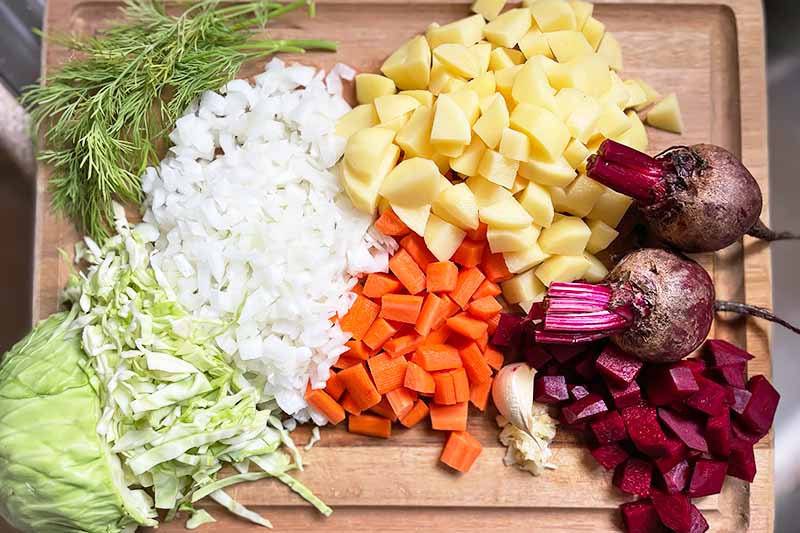
Reserve some of the smaller beet greens for a bright garnish if they’re intact, or save them for recipes like this sautee since they’re less bitter when cooked.
Mince the garlic, remove the core and chop the cabbage, and finely chop the dill. You can also use kitchen scissors to snip the dill if you prefer, since it’s such a delicate herb.
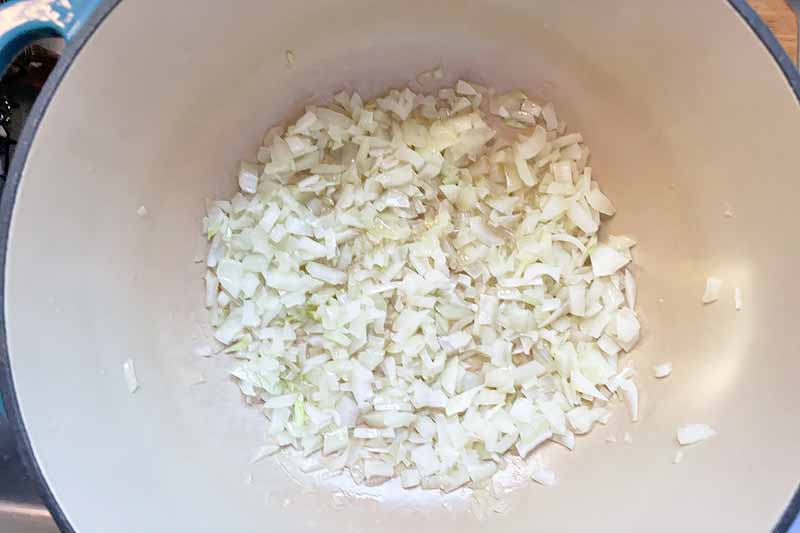
In a large heavy-bottomed saucepot or a Dutch oven, melt the butter and warm the olive oil over medium heat.
Add the onion and allow it to sweat until it’s very fragrant and translucent. This should take about 5 minutes.
Step 2 – Saute the Root Vegetables
Set the cabbage aside, since it won’t be added until the final 10 minutes of cooking.
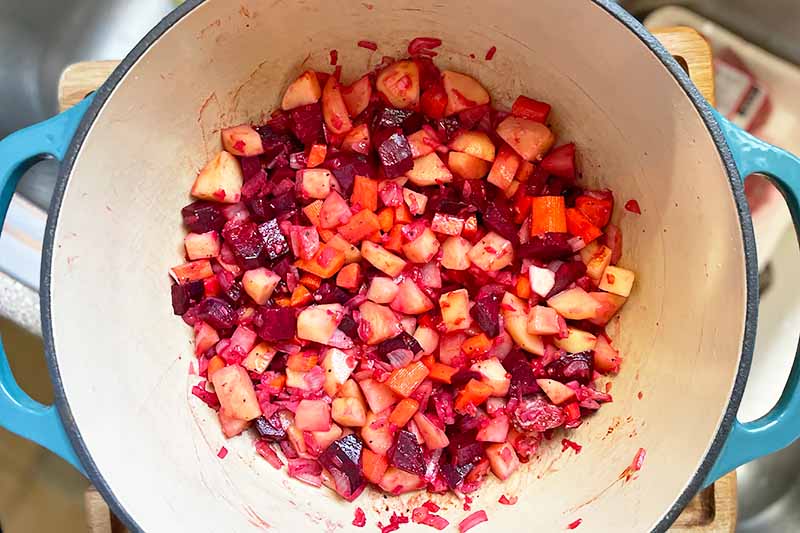
Add the carrots, potatoes, and beets to the pot. Saute until the veggies are lightly golden on the outside, stirring occasionally, for about 5 minutes.
Stir in the garlic and tomato paste, and cook for 1 minute or until fragrant. Don’t allow the garlic to brown.
An excellent tip for storing tomato paste – since it’s an ingredient that’s used sparingly – is to transfer the leftovers to a zip-top bag. Flatten the paste into a thin sheet, freeze the bag, and then break off pieces when you need them.
Sprinkle the veggies with the salt and pepper, and stir to make sure everything is evenly seasoned.
Step 3 – Add the Stock and Simmer
Pour in the vegetable stock and bring the mixture to a boil.

Store-bought stock is fine, though I think homemade is always best. If you’re not serving this soup to vegetarians, this slow cooker chicken stock will add deep, rich flavor.
Reduce the heat to medium and continue to simmer until the carrots, potatoes, and beets are tender but not mushy, for about 20 minutes.
Step 4 – Add the Vinegar and Cabbage, and Serve
Add the cabbage and vinegar, and stir to combine. Apple cider vinegar adds a little sweetness, but lemon juice works just fine since acid is the prominent flavor you want.

Simmer until the cabbage wilts but still has some crunch, for about 10 minutes.
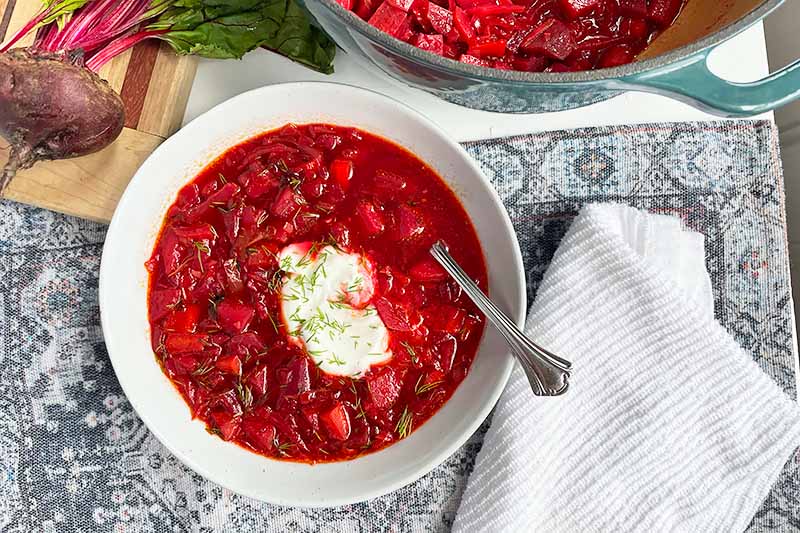
Season to taste with additional salt and vinegar if you like. Divide the borscht among bowls and evenly garnish with the sour cream and chopped or snipped dill.
Bring on the Borscht
This filling soup is just the ticket on a brisk winter day, but it also freezes well so you can enjoy it throughout the seasons.

If you’re worried that this vegetarian soup might be lacking in substance, one bite will prove you wrong. With such an abundance of potatoes, carrots, and cabbage, I promise you won’t miss the meat.
Sweet and sour is a traditional combination in Ukrainian and Russian cuisine, but feel free to adjust those flavors to your personal preference. A crusty baguette is a no-brainer for swiping up the magenta morsels that are left at the end, but buttered rye bread is even better.
Can’t get your hands on a loaf of rye (Seinfeld, anyone)? Toasted caraway seeds stirred into your sour cream will achieve a similarly licoricey bite.
How will you go wild with your garnish for this borscht? Share your soup topping suggestions in the comments below! And don’t forget to give this recipe a five-star rating if you loved it.
If you’re on the hunt for more meat-free soups, check out these other vegetarian classics next:
Photos by Fanny Slater, © Ask the Experts, LLC. ALL RIGHTS RESERVED. See our TOS for more details. Last updated on January 27, 2022.
Nutritional information derived from a database of known generic and branded foods and ingredients and was not compiled by a registered dietitian or submitted for lab testing. It should be viewed as an approximation.
About Fanny Slater
Fanny Slater is a home-taught food enthusiast based in Wilmington, North Carolina who won the “Rachael Ray Show” Great American Cookbook Competition in 2014, and published her cookbook “Orange, Lavender & Figs” in 2016. Fanny is a food and beverage writer, recipe developer, and social media influencer. She was a co-host on the Food Network series “Kitchen Sink,” was featured on Cooking Channel’s longtime popular series “The Best Thing I Ever Ate,” and continues to appear regularly on the “Rachael Ray Show.”

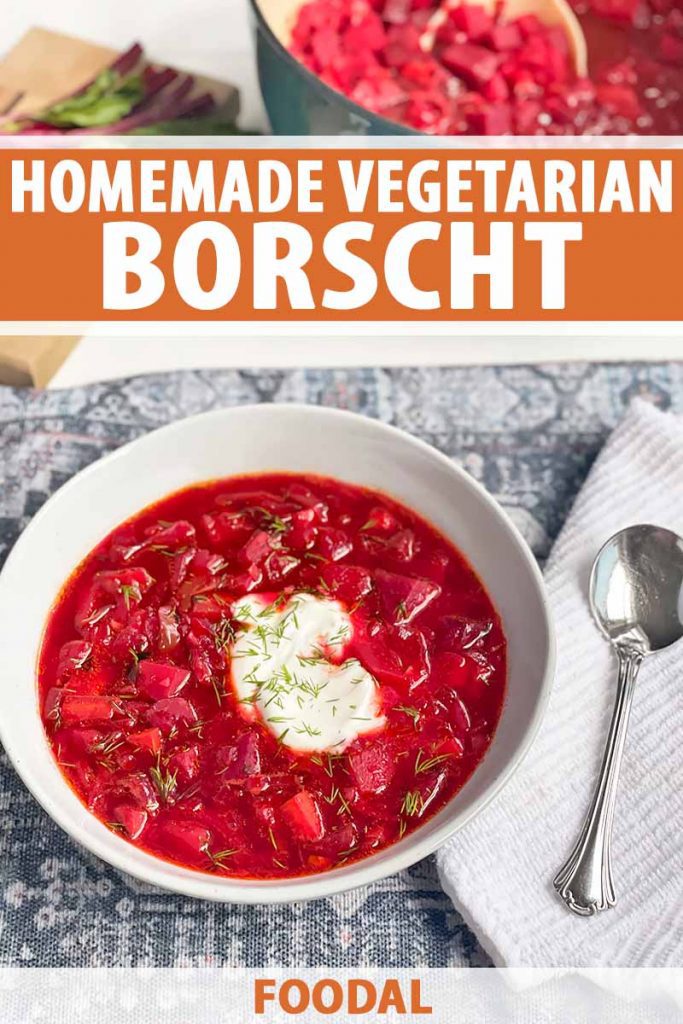



Wondering how long I can store this in the fridge? Also it’s wonderful thank you for the recipe!
★★★★★
We’re so glad you enjoyed it, Tayler! This soup can be refrigerated for 3-5 days, or frozen for up to 3 months.